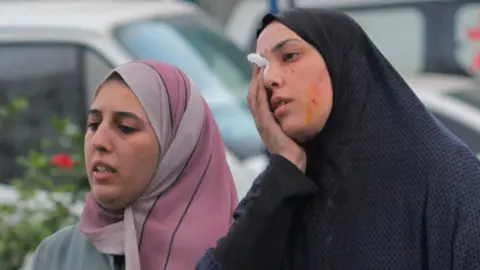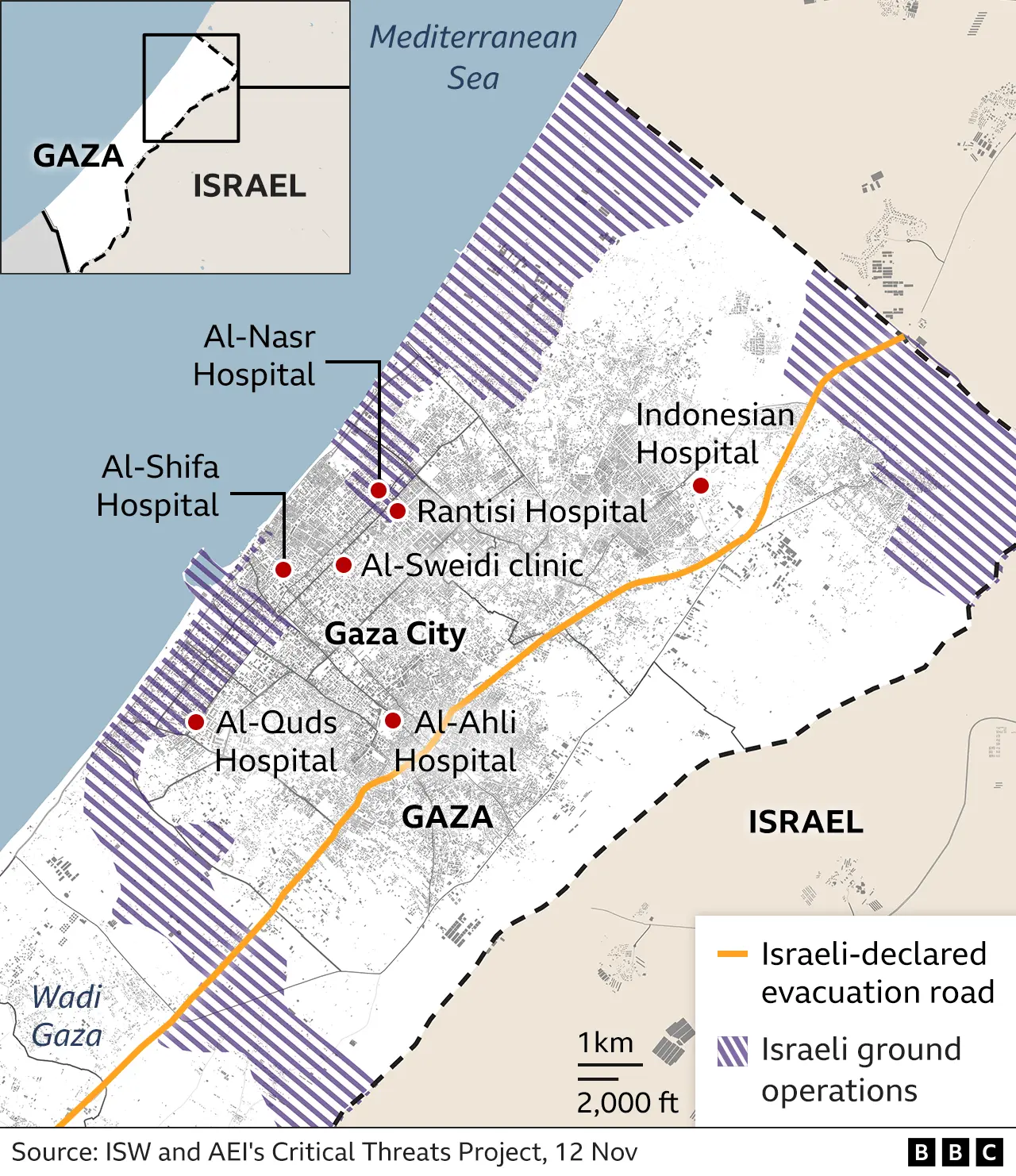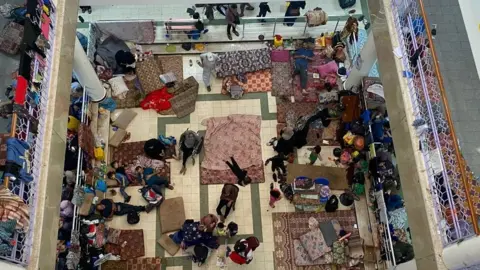Israel Gaza: Hospitals caught on front line of war
 Getty Images
Getty ImagesHospitals and medical facilities have become caught up in intense fighting as Israel presses its offensive against Hamas in Gaza City.
The focus of attention has been on Al-Shifa, Gaza's largest hospital, where thousands are trapped by nearby battles, but other facilities are also reporting a lack of supplies and power because of fighting.
Israel says it is not targeting hospitals directly but acknowledges "clashes" around Al-Shifa and other facilities.
The World Health Organization (WHO) says 36 health facilities including 22 hospitals have been damaged since the war began on 7 October, and only a handful are now still operational.
Here is what the BBC knows about the situation at the main facilities in northern Gaza.
Al-Shifa Hospital, Gaza City
The WHO said on Sunday that Al-Shifa in Gaza City - the territory's largest with 700 beds - had ceased to function and that the situation inside was "dire and perilous".
The surrounding streets are engulfed by fighting between Hamas and Israeli forces. Critical infrastructure has been damaged, according to the UN.
Israel says Hamas fighters operate in tunnels underneath the hospital - a claim which Hamas denies.
Staff inside say it is impossible to leave without risking injury or death.
The WHO Director-General, Tedros Adhanom Ghebreyesus, said on X that "constant gunfire and bombings in the area" had "exacerbated the already critical circumstances".
Multiple reports from inside say there are no food and no fuel to run generators. Solar energy is being used to power a few critical systems.
There have been communication blackouts - the Doctors Without Borders charity was unable to contact its members inside Gaza over the weekend. Attempts by the BBC to contact workers have often been unsuccessful.
The Hamas-run health ministry has said there are at least 2,300 people still inside the hospital - up to 650 patients, 200-500 staff and around 1,500 people seeking shelter.
This number includes newborn babies being kept in a surgical theatre at the site.
Staff say that three of 39 infants in their care died over the weekend for lack of incubators. Surviving babies were at serious risk of death, according to doctors.
The Israel Defense Force's (IDF) chief spokesman, Rear Admiral Daniel Hagari, said on Saturday that Israel would provide assistance to evacuate the babies to a "safer hospital".
However, that evacuation had yet to happen as of Monday afternoon.
Hospital staff have told the BBC that moving the babies safely would require sophisticated equipment, and that there is no "safer hospital" inside Gaza.
Mark Regev, a senior adviser to Israeli Prime Minister Benjamin Netanyahu, said that the 300 litres offered would have been enough for the babies and more could be provided.
"Hamas did not want to accept solutions for the lack of fuel needed to save the babies," he said, adding: "We provided fuel and they [Hamas] refused to take it."
 Reuters
ReutersOn Saturday, Colonel Moshe Tetro of the IDF said there were clashes nearby, but no shooting at the hospital itself, and no siege.
Anyone who wanted to leave, he said, could do so. He insisted that to say otherwise was a lie.

More on Israel-Gaza war
- Follow live: Latest updates
- From Gaza: ‘So crowded we can’t even sleep on our backs’: Gaza shelters at breaking point
- From Israel: How much closer is Israel to its goal in Gaza?
- Explained: The faces of hostages taken from Israel
- History behind the story: The Israel-Palestinian conflict

Marwan Abu Saada, a surgeon in Shifa, told the BBC that there was bombing around the hospital and ambulances could not get in.
The IDF also said efforts to deliver 300 litres of fuel to Shifa on Sunday had failed because Hamas had refused to accept it - something Hamas denied.
Mr Abu Saada told the BBC on the same day that 300 litres would "last 30 minutes" - the hospital needs 10,000 litres a day to operate normally.
On top of this is the growing risk of disease from lack of sanitation and the decomposition of dead bodies that cannot be refrigerated.
Mr Abu Saada said that attempts to bury the dead had been thwarted by fighting around the complex, and the morgue refrigerator had failed for lack of power.
There were 100 bodies unburied in the hospital courtyard, he added.
Dr Marwan Al-Barsh, director general of Gaza's Hamas-run health ministry, said that as well as the courtyard, the hospital's mortuaries were also filled with corpses.
He added that hospital officials had tried to bury those who had died in the hospital, but that people had been unable to leave without coming under fire.
Israel says it knows "with certainty" that there is a Hamas command centre underneath Shifa.
It has shared a 3-D representation of what it said were a network of tunnels under the hospital, and recordings it says are of Hamas fighters discussing them.
Hamas denies it is using the hospital or that it has an operations centre underneath. Doctors inside insist there is no Hamas presence there. The BBC's Gaza correspondent Rushdi Abualouf said that he had never seen "any military capability" inside the hospital, but acknowledged it was difficult to verify either Israel's or Hamas's claims.

Al-Ahli hospital
WHO's Dr Tedros said on 10 November that the hospitals that were functioning in the Gaza Strip were "operating way beyond their capacities".
Dr Ghassan Abu Sittah, a doctor working at Al-Ahli in northern Gaza, told the BBC that the hospital was now taking all of the wounded from Gaza City but that it did not have the resources to cope.
He said that ambulances were arriving with wounded people every 10 minutes, and that hospital staff did not have access to a blood bank, which he said was surrounded by Israeli tanks.
"We don't have an x-ray technician and we are short of medication to the point where we're having to do extremely painful procedures on large wounds to keep them clean with no analgesia, no anaesthetic," he said.
He added that operating rooms were being saved for life-saving surgeries "because we don't have enough resources to treat everybody".
Last month Al-Ahli was the scene of a deadly blast that was at the centre of competing claims between Israel and Hamas about who was responsible.
Al-Quds hospital
The Gaza Strip's second largest hospital after Al-Shifa has, according to the Palestinian Red Crescent, ceased to be operational.
The Palestinian Red Crescent said on Saturday that its teams were trapped inside with 500 patients and around 14,000 displaced people, mostly women and children.
On Sunday it stated that the hospital was "out of service... no longer operational... due to the depletion of available fuel and power outage".
It added that the hospital "has been left to fend for itself under ongoing Israeli bombardment, posing severe risks to the medical staff, patients and displaced civilians".
It also said that an "evacuation convoy" travelling from Khan Younis in southern Gaza towards Al-Quds hospital had had to turn back after experiencing "relentless bombardment". It added that those trapped in the hospital were without food, water or electricity.
Doctors Without Borders said on Saturday it had lost contact with a surgeon working and sheltering in Al-Quds with his family.
A spokesman for the Red Crescent told Reuters news agency that the hospital had been cut off for nearly a week, with "no way in, no way out", and the surrounding area was under constant attack.
Al-Rantisi and Al-Nasr, northern Gaza City
The small Rantisi Specialised Hospital for Children and the nearby Al-Nasr hospital, in the north of Gaza City, were evacuated on Friday save for a handful of patients and staff. Rantisi had Gaza's only paediatric cancer ward.
The IDF released to the BBC details of phone conversations between an official at Rantisi and a senior officer in the IDF, in which they discussed arrangements to get ambulances to evacuate patients.
The hospital official asked about hundreds of displaced civilians camped out at the two hospitals. The Israeli officer told them to leave via the main entrance at 11:20 and explained in detail which streets they should walk along to leave Gaza City.
And he twice told the hospital official to make sure civilians were carrying something white to show they were not combatants.
"They will all go out with their hands in the air," the hospital official said. "Perfect," the Israeli said.
In a video verified by the BBC, people waving white flags were seen apparently coming under gunfire on as they attempted to leave Al-Nasr on Friday. It was not clear where the gunshots had come from or who had fired them.
Dr Bakr Gaoud, the head of Rantisi, was quoted by the New York Times as saying that Israeli forces had arrived at the end of last week and provided maps showing a safe way out.
"We dragged our patients out of their beds," he said, adding that the patients in the worst condition were sent to Al-Shifa, which was already overwhelmed and ceasing to function.
Everyone else, he said, had made their way to southern Gaza away from the main fighting.
On Monday evening IDF spokesman Daniel Hagari showed journalists what he said was evidence of Hamas infrastructure at Rantisi - video of explosives, suicide vests and even a motorcycle used in the 7 October attacks, hidden in a basement.
He showed video of a deep shaft with a ladder down the side which he said was the entrance to a tunnel that was next to both a school and the hospital, adding it was "nothing else but a terror tunnel".
 Reuters
ReutersAl-Sweidi (Swedish) clinic, Shati camp
The UN's office for humanitarian affairs said in its Sunday night update that the Swedish clinic had been "hit and destroyed" by an air strike on Saturday.
There were around 500 people sheltering there, it reported, and the casualty toll was "unclear".
On Monday morning, BBC Gaza correspondent Rushdi Abu Alouf spoke to Maryam al-Arabeed, a 65-year-old woman who said Israeli soldiers had entered the facility on Sunday night and moved everyone out. She said she had then watched "an Israeli bulldozer completely demolish the building".
"They took the young men out including my three sons and separated the women and children," she told the BBC.
She added that she did not know where her sons or relatives were.
The IDF said it was investigating the report.
"In start contrast to Hamas's intentional attacks on Israeli men, women and children, the IDF follows international law and takes feasible precautions to mitigate civilian harm," the Israeli military added.
